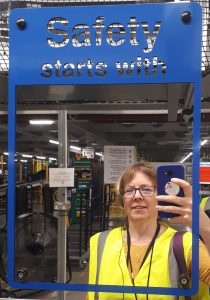Robots at Amazon UK
First published in Health and Safety at Work Magazine, July 2019. Amazon images courtesy of Amazon UK, (C) Blake Ezra Photography Ltd. The rest copyright The Safer Choice Ltd
Robots and cobots still exist in the future for most of us. But for Amazon customers, a robot quite possibly helped pick your last order. Six of Amazon’s 17 fulfilment centres in the UK, use “robotic drive units” alongside the human workforce. Worldwide, Amazon has a fleet of 100,000, developed after it acquired a robotic fulfilment specialist, Kiva Systems, in 2012, rebranding it as Amazon Robotics (AR). I was invited to the Tilbury fulfilment centre to see the brave new world of collaboration between human workers and robotic colleagues, and how safety principles are adapting.
Even as I parked my car at Amazon’s Tilbury fulfilment centre (FC), one of 17 in the UK dispatching thousands of orders an hour, I could tell that this is an organisation that aims to make safety visible. Signs request that drivers reverse into parking spaces, with an illustration reinforcing the message. Later, speaking to Robert Burnett, senior safety manager for Amazon UK, he explains that “we know that the majority of accidents in car parks occur when people reverse out of parking spaces, and at shift handover the car park can get quite busy”.
On a Wednesday in May, the site didn’t seem busy, with plenty of spare parking spaces, unused working positions, and empty chairs in the break areas. Spread over 186,000 square metres and four floors, it’s hard to believe there are 2,000 people on site. The extra capacity is needed for the busy times of the year, with Black Friday, Christmas or special offer “Prime Day” seeing staffing rise to 5,000. Most workers – known as “associates” – looked quite young, although there were some more experienced faces amongst the “stowers”, pickers, packers and engineers.
Another visible sign of the safety focus is a sign reporting the number of days since the last reportable injury. “As Amazon is an American company, we use the OSHA [Occupational Safety and Health Administration] criteria,” Burnett clarifies. “It’s much stricter than the UK RIDDOR reporting criteria. If someone has a shoulder ache they believe is caused by work, under RIDDOR we’d only report it if they had more than seven days off work. Under OSHA we have to report it if their doctor gives them a prescription pain killer.”
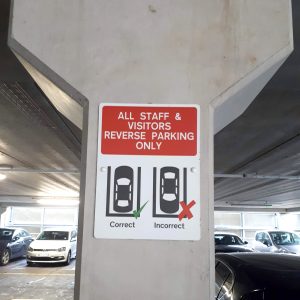
“OSHA reporting criteria is much stricter than RIDDOR. Under OSHA, we report pain if their doctor gives them a prescription pain killer”
Robert Burnett, senior safety manager, Amazon UK
New world symphony
At the FC’s reception there was a huddle of visitors – members of the public, waiting for a pre-booked tour. As instructed, all were wearing flat shoes as blue-vested tour guides provide an introduction to their morning. Burnett comments that there’s no need for visitors to wear safety boots. “We’d rather work from the top of the hierarchy and eliminate hazards that would require safety boots.”
Safety footwear is needed in limited areas, with safety trainers chosen by staff after consultation with Amazon’s “Associates’ Forum”. This meets three times a month, and the names, photos and job roles of its members are displayed next to the first-aid station and other notice boards.
“Employee representatives work directly with site leadership to escalate and resolve questions and concerns about the working environment,” Burnett says. To reinforce the approach, there is a recognition scheme called “Safety Saves/Safety Solvers”, which rewards associates for the best safety insights.
In the reception, there are more signs of making safety visible, with copies of operational safety rules on material transport, pallet-racking and safety incident reporting displayed on the wall. There’s a large whiteboard labelled “Voice of Associates”, equipped with pens for colleagues to add any suggestions, complaints or safety concerns. On my visit there were no safety concerns listed, but a couple of complaints about the quality of tea and coffee.
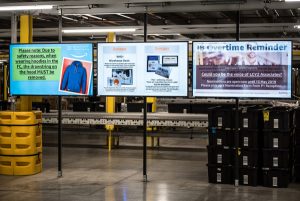
My impression at the Amazon fc were generally very positive, and I am convinced of the sincerity of the safety professionals I met. However, for a balanced view you might want to read the ‘Amazon workers are not robots‘ campaign from the union, GMB. I have not checked out the evidence they present, and leave it to the reader to look at both sides of this debate. Bridget Leathley in 2021
Worker participation and engagement are supported by an “open-door” policy, which encourages staff to discuss any suggestions or concerns with managers directly. To reinforce this relationship, managers carry out a daily safety walk alongside an associate, making it easier for even the newest recruit to access the most senior managers. For those reticent about approaching managers or the forum, “Amazon Connections” software asks all associates a question each day (either via the computer they are logged into, or a hand scanner), with the information used to inform workplace improvements.
“We give people as many ways as possible to raise safety concerns. We get a lot of engagement, and a lot of good suggestions,” Burnett says, describing a recent idea that the cardboard bins used to stow small packages could be slightly smaller. “Smaller bins were available, so the change was implemented within days. It led to a significant improvement in the ergonomics of the handling process, and made damage to the packets less likely.”
Staff engagement is one of the reasons Burnett enjoys working for Amazon. “I’ve worked for other companies where suggestions from any level in the workforce were not taken seriously. Even with me being a health and safety professional, they didn’t really want to know how to make things better. At Amazon, I’m always asked for my contribution to any new project, right at the start.”
From robotic first principles
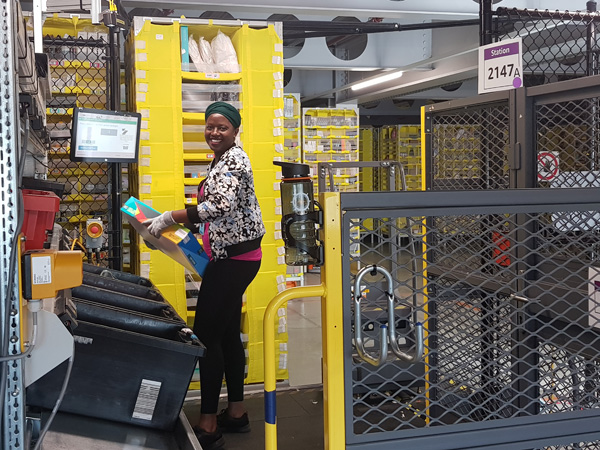
One such project was the fitting out of the Tilbury FC, which has been designed to have robots assisting workers from day one. In the design phase, Burnett was flown to New York to see an AR fulfilment centre there, to see what worked, and what changes were needed for the UK. One significant difference was that EU-driven machinery guarding requirements are more stringent than those in the US, so Burnett worked with engineers and an ergonomist to design the guarding that keeps untrained people away from the robots and conveyors.
At Tilbury, workers do not need to walk up and down aisles with trolleys to place stock on shelves, known as stowing, or to select items to fulfil orders, known as picking. Instead, robots assist the associates to stow items in yellow storage pods when stock arrives, and to pick the items to meet customer orders.
The robotic units themselves are almost invisible underneath the multi-compartment yellow storage pods they are designed to move. By the standards of science fiction, these orange robots are pretty basic. Each is about 20 cm high, and 75 cm square, and runs on wheels. A camera underneath allows it to read quick response (QR) codes on the floor, so it knows where it is, and a second camera on top reads the QR code on the pod, so it knows what it’s carrying.
Algorithms in the operating software work out which pod has spare storage capacity that can be used by human stowers, or which pod should be delivered to a packer to fulfil an order. Once the route is mapped out, the robot takes the correct pod of inventory to the associate for items to be either stowed or picked. The yellow pods move smoothly around a designated robot-only area, rotating to deliver one of four sides to a trained associate. It’s an approach that apparently permits 40% more inventory to be stored compared to convenional racking.
The interface between associates and robots is strictly controlled. Associates are not allowed to cross the line into the robot area, where the robots shuffle around, swap position and wait for their turn. This is reinforced during initial training and refresher courses, and by warning signs at the entry point to the robot zone. The units can “see” an obstacle directly in front of them and avoid it, also relaying a message to other robots to avoid the area. For instance, the robot could detect a stationary person (if someone fell on the floor in the robot area), but Burnett is less confident it would always avoid a moving person.
If an associate notices an article has fallen out of a pod onto the floor, they are under strict instructions not to enter the area to pick it up, even if it is within easy reach. Instead, they call for an Amazon Robotics (AR) responder, distinguished by their red jackets. Responders are trained to maintain the robots, and on how to stay protected in their area of operation.
“AR responders use a tablet to define an exclusion area, and the robots will stay clear of that area,” Burnett explains. However, setting the exclusion area size took some tweaking in the early days. “We were puzzled that the robots on one floor were avoiding an area for no apparent reason. Then we realised it was happening every time an exclusion zone was set on the floor below – the zone extended too high upwards. We reduced the range, and the problem was solved.”
He describes setting up the exclusion area as “a bit fiddly” and is excited by the latest development in this field, a vest or harness worn by associates that is integrated with a Short-Range Broadcast Radio frequency System (SRBRS), pronounced as Cerberus. “It continuously broadcasts a short-range override radio signal in all directions,” explains Burnett. “Robots slow down when in medium proximity, and stop when in close proximity to the vest.”

Traffic lights
Anyone who spots someone on the robot floor not wearing a red jacket has been instructed to hit the red emergency stop button, which will also turn the facility’s traffic lights red. Each station has its own set of lights, which can be viewed quickly by looking down the corridor of picking, packing or stowing stations, or from above on a gantry. Green indicates normal operations, amber signals that non-urgent help is required, red means there is an emergency, and blue indicates that assistance is needed with unblocking a machine.
“Stowing” looks like a random process, with CDs stored next to toys and above in the pods. Burnett spent a week stowing, picking and packing, so he can explain the rules from experience. “As each new item is stowed in a pod cell, the associate scans both the item and the shelf reference, so that the exact location of each item is known. If they attempt to store a heavy item too low or too high, the computer will alert them to this.”
Watching robots delivering yellow pods is mesmerising, with human, robot, software and conveyors working in synchronisation. A computer screen above a picker’s head drives the process. Once the pod is in place, the screen displays the shelf number to pick from, and an image of the item to pick. Up to six orders can be picked at once, but pickers can choose to work on a smaller number (the picker we watched had just three plastic bins or “totes” on the go).
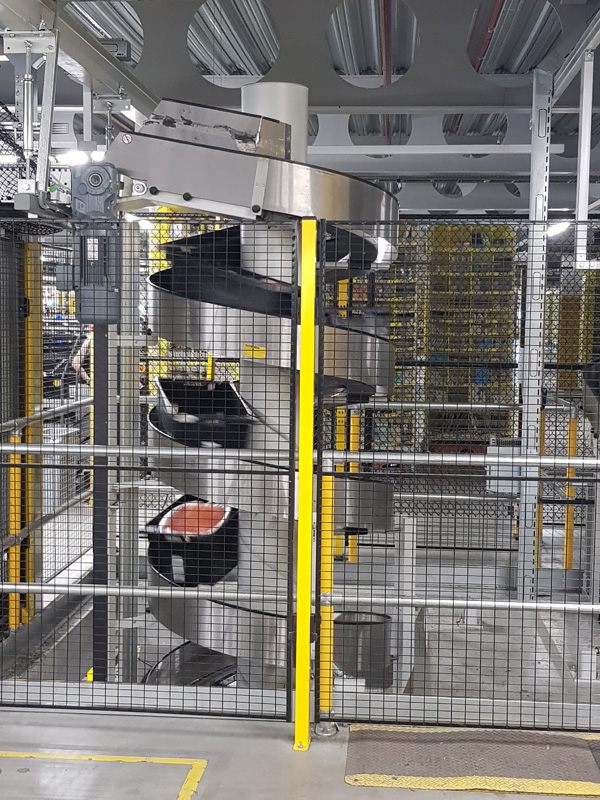
A light flashes above the tote where the item is to be placed, and the picker presses a button to confirm the item went in the correct tote. If a subsequent item can be picked from the same pod, another shelf reference and image flash up on the screen. If not, the pod moves away, and the picker stands back and stretches, waiting for the next pod to arrive.
I ask Burnett if there are breaks built into the software, to impose a rest after a set period of activity. “We haven’t found it necessary. There are natural breaks when the pods are being changed, and if a picker wants to stop for a drink or a toilet break, the workflow just waits until they press a button again.” Burnett points to the water bottle holder fixed to the guarding of the picking stations, noting that it was added on the suggestion of an associate.
Staff are encouraged to keep a bottle of water with them, and after inductions are given an Amazon branded one that can be refilled from stations – some offering sparkling water – on every floor.
Manual handling training is provided in initial training and annual refresher training, and the design of the workstation makes it possible to adopt good handling techniques. There is plenty of space to turn around and walk to each tote, and no need to twist. The height of the totes allows items to be dropped straight in, without bending or reaching. Once the order is complete, a gentle push moves the tote onto a conveyor for onward movement to a packing area, while a new tote is pulled down from the incoming conveyor.
This hasn’t eliminated manual handling – empty totes have to be piled onto a trolley, wheeled to the workstation and loaded up. But once filled with a customer’s goods, the totes spiral down to the packing floor, where they can be nudged onto the packing station (see photo, above). Lifting for an individual is limited to 15 kg. “Anything heavier is automatically marked up for a team lift,” says Burnett.
My colleague is a drive unit
Tilbury has had the robots as part of its operations from day one, so changes to the way of working have not created any staff issues. Burnett notes: “For a lot of new staff there’s a real ‘wow!’ factor when they first see the way we work. Most people will work some shifts with the robots, and some shifts with conventional mechanisation. We can be flexible around preferences, but no one has objected to working with robots.”
Diego Sabella, health and safety manager on the Tilbury site, specifically requested to work there because he was enthusiastic about the possibilities the robots offered. “Our Tilbury fulfilment centre is a very exciting place to be, with lots of opportunities to grow and learn. The robotics technology really impressed me and even after being here for over 18 months, I am still fascinated.”
Although there’s no data to show that musculoskeletal problems are any different at Amazon’s six UK sites using AR devices, compared to the 11 sites using conventional methods, Burnett highlights other measurable differences. “Associate engagement is higher on AR sites. We get more suggestions and ideas coming through as to how processes can be improved, which can relate to safety or quality or both.”
Burnett gives a recent example. “We have a daily inspection, driven by a checklist on a tablet. I suggested that rather than asking the same question set every time, we focused on a particular area for each inspection, and then drill down in more detail. Amazon software developers in India are now working on some code to do that, and priorities will be adjusted by audit results or reported incidents. I’m looking forward to seeing the results,” he tells me.
Burnett has also suggested that the inspections should be an opportunity for giving more useful feedback to workers. “If we spot that something isn’t as it should be, it would be great to be able to show a short video clip to reinforce the correct procedures, rather than just noting the problem. The developers are working on that too.”
A PPE vending machine allows staff to select replacement high vis jackets (in standard issue orange), safety gloves and ear plugs. “We’ve shown everyone how to use the plugs, and explained that they are advisory, not compulsory. We have an external expert carry out a noise audit on every site every year, as noise levels can creep up, but we’re not exceeding exposure action levels,” says Burnett.
There is acoustic sheeting between the noisiest areas, and a low-level background hum. As a distraction, there is music playing in some parts of the building, with associates voting on the music style to be played for the following week.
“The robotics technology really impressed me and even after 18 months here I am still fascinated“
Diego Sabella, health and safety manager, Amazon Tilbury
Training options
Burnett is proud of the safety training programme, which offers everyone, from the most senior manager to a student packer, “day zero” training. “This covers what everyone at the FC needs to know, such as safety policy, fire prevention and evacuation, manual handling and accident reporting, as well as making sure they know about all the amenities – the canteen, the water stations, the toilets and so on,” says Burnett.
Day one training is more specific to the role an associate is employed for, but all managers spend a week learning to stow, pick and pack. Associates are usually started in one role, but are then trained to do stowing, packing and picking. “If there is a gap of more than 90 days of not carrying out a particular task, they have a two-hour refresher before they re-start that job,” says Burnett. Twice-a-shift safety tip sessions are used to reinforce the safety messages. “These are short reminders of some particular aspect of safety. Every shift starts with one, and there’s another one after their main meal break,” he says.
Fire drills are held four times a year, to make sure that people on all shifts have the opportunity to be involved. Amazon also practices “invacuations”, where staff take cover inside the building. “The need for this has been influenced by the US, where the problem of terrorist shooters is taken seriously. It could happen anywhere, and we want to be prepared.”
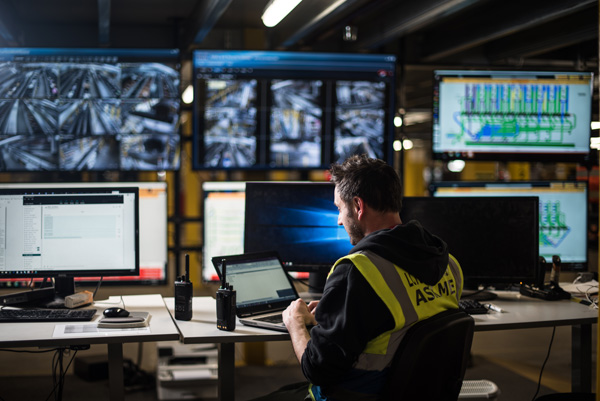
“The need for invacuations has been influenced by the US, where the problem of terrorist shooters is taken seriously”
Robert Burnett, senior safety manager, Amazon UK
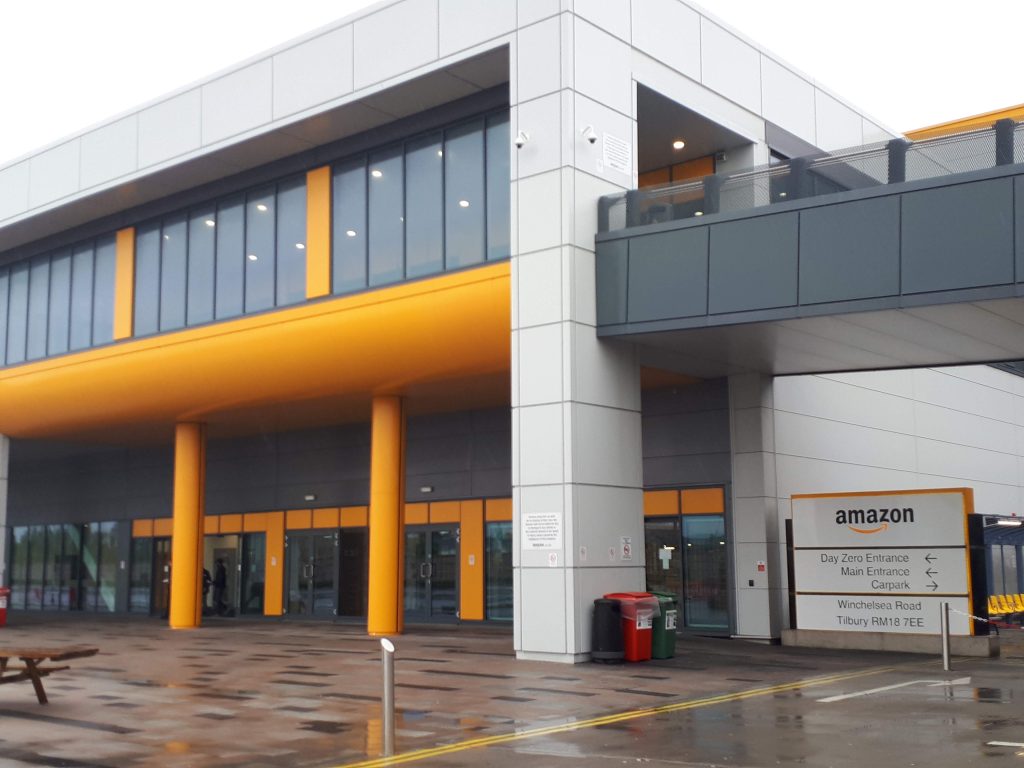
Where next?
Three demonstration robots hang from the ceiling over the exit scanners, and look like unremarkable orange pallets. However, more impressive is what you can’t see – the sophisticated software that tracks each item from delivery, to stowing in a yellow pod, knowing when to move which pod to which picking bay, and continuing to track the item in its tote to the packing station, through labelling to the outward bound bay.
Burnett is excited about where technology will take Amazon in the future. “The World-Wide Design in Safety business team is looking at new design solutions for the Amazon Robotics stations. These will be built into new stations, and where we find wins, we will upgrade and retrofit all other stations. What you’ve seen today could be quite different in a year’s time.”
